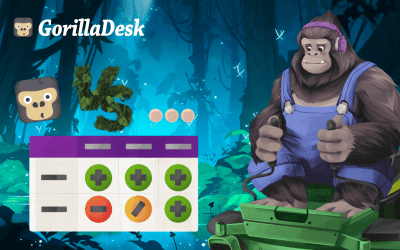How to start a pest control business: Your winning plan
GorillaDesk Staff

So you’ve been working in pest control for a while, you perform well, and you’re feeling a calling to start your own thing.
Your mind may be racing over the challenges, obstacles to success, requirements — and all of the lucrative possibilities. You’re wondering exactly how hard it’ll be to start a pest control business, right?
Not only is it doable and realistic, but it can be a super profitable and fulfilling move — as long as you have the right resources. We’ve put together a step-by-step, in-depth action plan to set you on the right path for your new pest control business.
We realize there’s no cookie-cutter, single-right way to start a pest control business. So we’re covering the gamut of new pest control business development, but as with any business, it’s important that you do it in your own way, putting your own spin and personality on things and taking true ownership of your new business.
So, if you’re ready to turn your dream of owning a pest control business into a financial reality, let’s dive in.
What to know before you start your pest control business
Okay, you’re ready to get started — at least, you think so. But pest control is a far-reaching and technical industry, and what you don’t know might work against you. Here are some things it’s nice to know before you make things official.
What does a pest control business entail?
Pest control encompasses a whole lot of services, so choosing the right niche for your business will be key. The pest control industry includes:
- Residential pest management
- Commercial pest control
- Specialized services like termite control, bed bug treatments, and wildlife management
Start by figuring out what services you want to specialize in based on your expertise, local demand, and competition. Then you can tailor your offerings and marketing strategy to the best impact. You can also consider the option to provide other services like lawn treatment (think fertilizer services) in your down time or off season.
How much can you really make as an owner of a pest control business?
There’s good money in pest control — especially if you’re strategic in how you set up and run your business. Not only is it a growing market, estimated to grow from $24.1 billion in 2023 to $31.8 billion by 2028, but the revenue possibilities are promising.
But how much can you actually earn? The average pest control business earns just over $400,000 in gross revenue annually, with about a 45% profit margin after all operating costs. Not too shabby.
Of course, your potential earnings will depend on a few factors, including your business model, location, pricing strategy, and operating costs. But if you follow some tried-and-true strategies (we’ll get to those), you can improve your chances of maximizing your profits.
Pros and cons of starting a pest control business
Like any business, starting a pest control business comes with its own challenges and rewards. The good news is it offers a number of advantages:
- High demand: Pest control services are in constant demand, which means there’s a steady flow of potential customers.
- Recurring revenue: Traditional pest control services require regular servicing, which provides business owners a consistent flow of revenue through service contracts.
- Diverse market: Since you can serve various sectors as a pest control business — including residential, commercial, and agricultural — there’s the potential for multiple revenue streams.
- Low startup costs: Compared to other businesses, starting a pest control business can have relatively low initial costs, with average startup costs of $12,272, though the cost could be lower if you already have a license and some equipment.
- Flexibility: Being a business owner gives you the flexibility to set your own hours and work on the schedule that you prefer.
Of course, every industry has some disadvantages. A few cons of owning a pest control business include:
- Competition: The pest control industry is quite competitive, with more than 32,400 companies already operating nationwide, making building a client base more challenging; you’ll need to put more effort and resources into marketing to stand out.
- Regulatory hurdles: Because of the type of substances involved, pest control is subject to stringent regulations. It’s important to stay informed of and comply with local, state, and federal laws, which can be time-consuming.
- Seasonality: Depending on your location and the types of services you offer, demand for pest control services can be seasonal, affecting your revenue during certain times of the year. As we mentioned, though, you can come up with some creative ways to generate revenue in the off-season.
- Initial investment: Startup costs are relatively low, but you’ll still need to invest some funds to get off the ground and cover things like specialized equipment, vehicles, operator licenses, and business registration.
- Liability risks: Since pest control work comes with risks, you’ll need comprehensive insurance to cover potential damages or health risks to customers.
Should you start your own business or buy into a franchise?
In the pest control industry, this is a big decision. Starting your own business gives you the freedom to create your brand and operate on your terms, but it also means building everything from the ground up. In such a highly competitive market, it can be tough to break in when you’re starting from scratch.
In contrast, buying a franchise offers you a proven business model, brand recognition, and support from the franchisor. Most pest control franchise companies also offer some level of training. Keep in mind, though, that this model comes with franchise fees and less operational freedom. The initial investment for major pest control franchises ranges from $15,000 to over $100,000 for more specialized pest control services like bed bugs — and this doesn’t include any additional annual fees.
It pays to do your research here — and the industry is teaming with people open to passing on their experience and insights. Get to know your local pest control market and identify areas of opportunity, then make the decision whether to go it on your own or jump aboard a franchise.
Starting a pest control business: The basics
So, you’ve decided on your business model and are ready to hit the ground running. Now, it’s time to make things official. Don’t worry—this part can still be fun—it starts with brainstorming creative business names.
But let’s not overlook how hard it can be to run your own business. A word of caution: the road to a six-figure pest control business is going to be long and hard. There’s no overnight success or shortcuts—just hard work, late nights, blood, sweat, and tears. But if you can keep a positive attitude through it all and stay focused on your end vision (a thriving, lucrative business), you’ll be well on your way.
1) Choosing your pest control business name
Choosing the right name for your pest control company is critical — it will become the basis for all future branding. Keep in mind that naming will impact your company throughout its lifespan, so it’s an important decision to get right.
When it comes to naming your company, make sure to consider trademarks, domain availability, and long-term suitability. We recommend keeping things simple. Here are a few must-follow tips:
- Include the phrase “pest control” in your business name. For example, Natural Resources Pest Control
- Keep your business name between 15-25 characters in length
- If possible, your business name and website URL should be the same
Have fun with it, play around with different possibilities, and ask your friends and family for input. Sometimes, a good name comes from something personal — a nickname, pet name, or something that’s important to you. Try to strike a balance between a name that’s relatively unique but still recognizable as a pest control company.
2) Deciding on your service offerings and service area
Before you get much further, it’s time to define the services you’ll offer and the areas you’ll serve. Here are some things to consider:
Identify your services
Think about your experience and any certifications you already have. Also, make sure to consider the types of pest control services that are in demand in your target market. If you don’t already have a service focus, here are some general service types to consider:
- Residential pest control: Services for homeowners dealing with common pests like ants, roaches, mice, and termites.
- Commercial pest control: Specialized services for businesses like restaurants, warehouses, and office buildings, which may require custom pest management plans.
- Specialized services: Focusing on specific pests, like bed bugs or termites.
- Wildlife control services: Removal of wildlife like rodents or snakes that have made their way into a property.
- Seasonal pest services: This is popular in certain regions where infestations occur during specific seasons, like scorpions in the southwest desert.
Choose your service areas
You also need to decide on the geographical areas you’ll serve. Depending on where you’re located, this decision may be straightforward or more challenging. For example, if you live in a small, rural town, you’ll likely offer services to the entire town and perhaps other parts of the county.
But if you live in a large metropolitan area, it may make sense to limit your service zone to city limits or certain zip codes in order to avoid racking up too many miles each day. Some other things to think about are:
- Competition: Look at the level of competition in potential service areas. Are there less saturated markets that you could target?
- Accessibility: Choose areas that are easily accessible. This will allow you to provide timely services to your customers — especially important for emergency pest control services.
- Growth potential: Expanding into rapidly growing suburbs or commercial zones could provide a steady increase in customers.
3) Registering your pest control business
If you’re starting out as a solopreneur, we advise keeping setup and compliance simple by establishing either a sole proprietorship or a limited liability company (LLC). The main advantages of the LLC business structure are:
- Tax filing is nearly as simple as for sole proprietorships and partnerships.
- An LLC is its own legal entity and the liability of the owner is very limited. That means if someone sues the business or the company, the owners’ personal assets are protected.
- Most states view the LLC as a disregarded entity for tax purposes — meaning that an LLC’s profits and losses flow through to the owners’ personal tax returns.
Make sure to properly register your pest control business with the local municipality and state. To learn more about registering your pest control company, visit this link.
4) Getting your pest control service license
To start offering pest control services, you’ll need a pest control business license — but remember, the licensing and certification requirements differ from state to state.
Make sure to check out your state’s Department of Agriculture (DOA) website to learn more about the state laws and requirements for obtaining a pest control license.
For example, if you’re in Florida, you can find all the information about the licensing and certification on the Florida Department of Agriculture and Consumer Services website.
For more information on your state’s licensing and certification requirements, visit this link.
5) Insuring your pest control business
When it comes to running a pest control business, don’t overlook insurance. It not only protects your business assets but also helps build trust with your customers. It’s an easy way to show people that you’re a professional, responsible business owner. Three key types of insurance to consider for your pest control business include:
a) General liability insurance
This is the foundation of your business’s insurance plan and will safeguard against the most common risks associated with pest control work. It covers a wide range of potential claims that could arise from your business operations, including bodily injury, property damage, and advertising injury.
b) Worker’s compensation
If your pest control business employs technicians or other staff, worker’s compensation insurance is often legally required. It provides coverage for employee medical expenses, disability benefits, and rehab costs. Basically, worker’s compensation protects your employees, who are the lifeblood of a healthy business.
c) Commercial auto insurance
Your technicians will typically be using company vehicles to travel to your customers, which makes commercial auto insurance a necessity. It covers vehicle damage, liability claims, and medical payments in case of an accident. Essentially, it helps protect your fleet of vehicles against the risks of the road.
6) Finding your unique selling proposition
A business’s unique selling proposition (USP), sometimes also called a unique selling point, tells people why your service offering is different from—and better than—the competition. In other words, it’s a specific benefit that makes your business stand out from others in your market. A strong USP is an important part of your brand identity.
As Lois Geller once wrote in an article for Forbes, “A brand is a promise.” It’s a promise to deliver a service that people can trust, one that they like. There will be people who don’t like your brand as well, but don’t worry about them—that’s the sign of a solid brand identity.
The biggest mistake in defining your USP is imitating someone else without putting your unique spin on your company. Instead of trying to blend in and mimic what other pest control companies in your area are doing, look for ways you can stand out from the crowd. Take what they’ve done and build on it. Or, turn it completely on its head and give it your own angle.
To articulate your USP, ask yourself:
- What your promise is: What do you and your audience value? What does your company stand for that makes you different or unique?
A good example of a brand promise is Natural Resources Pest Control. Their promise is to provide you with natural, non-toxic pest control services. Their customer base values safe pest control substances that aren’t harmful to their families, including their pets.
Take it a step further and build it into a statement or tagline:
- “Safe and proven organic pest control approved by experts.”
Remember, if you can offer a service or benefit that no one else offers, you’ll get more new customers and more new business. That’s the power of a compelling USP.
Starting a pest control business: Getting it off the ground
Okay, once you’ve nailed the basics of starting a pest control company, now it’s time to get it off the ground.
These steps all take time, but it’s important to put in the hours to get things right from the start since they’ll form the backbone of your pest control business. (Plus, we’ve got a couple of money-saving tips in here, too, to help you get off to a good start financially.)
1) Creating a website for your pest control business
An online presence is one of the foundations of any new business. A business website will allow you to start booking new services and generating revenue — all while you’re developing a positive reputation for your new company. But building a new website doesn’t need to break the bank.
You can create your website from many inexpensive website services with prebuilt templates. A lot of pest control companies have started with free WordPress themes and gone on to become successful, so there’s no reason you can’t, too. Get a simple yet professional site out there now, and worry about creating a polished, high-end website down the line once you’re more established.
The first thing to think about is how your website will look and feel. Here are some things to keep in mind:
- The website design should be appealing to the eye, and the text should be easy to read
- The copy on your website should clearly communicate your brand’s USP
- The images should represent your business and reflect your service area and target market
Start by getting the essentials locked down for your website and online presence:
- Website domain: Register a domain that is the same, or as close to, your business name as possible.
- Example: www.naturalresourcespestcontrol.com
- Hosting and SSL certificate
- Basic branding assets
- Logo
- Images for your website
- A business email address.
- Having a professional email id as [email protected] adds trust and credibility over a general Gmail or Yahoo email
- A business phone number
- A business email signature. Professional email signatures are a great opportunity to brand every message you send. They establish and reinforce who you are as a company. Also, you can provide important links to your recipients to share or promote information (deals, sale offers, events, etc). The easiest way to create good-looking signatures is to use an online generator like Newoldstamp or Mysignature.
- A business address.
Sell $100,000 worth of pest control services in the next 12 months.
Download Your Free SMART Goals Template here.
2) Pricing your pest control services
Your pricing shows your customers how much you value yourself, but very few pest control companies price their services correctly.
It’s understandable. With so many strategies and tactics out there, it’s almost impossible to know where to start.
Knowing how to price your pest control services correctly can either make or break your business.
So, how do you price your pest control services effectively?
a) Determining business costs
When you’re starting off, cost-plus pricing is a good starting point. The cost-plus pricing strategy — also known as markup pricing — is a simple pricing method where a fixed percentage is added on top of the total cost incurred to provide a service or manufacture a product.
The first step is to calculate the cost you’ll incur to provide a service. Think:
- Material/Chemical Cost
- Operational costs:
- Average fuel cost
- Drive time
- Equipment maintenance
- Vehicle maintenance
- Salary/wages for you and your staff
Once you figure out the numbers for the points above, you’ll have your baseline costs. In simple terms:
Baseline = Salaries + Material Cost + Operational Costs
After you estimate the baseline, you’re one step closer to deciding your final pricing. Now, it’s time to determine your markup.
b) Defining your markup
Markup is the percentage added to your costs to arrive at a price. Adding a healthy markup will help you cover overhead and ensure you actually turn a profit. Your markup can vary depending on things like the industry standard, your business’s USP, and the competitors in your service area.
It’s common to apply a markup that’s in line with industry norms, but it’s important to also consider the perceived value of your services to your customers. For example, compared to standard pest control services, specialized services like termite eradication might justify a higher markup because of their complexity and the high value they offer the customer.
c) Calculating profit margins
Your profit margin is the percentage of the selling price that is profit. To calculate your profit margin, subtract your total costs from the sales price, divide by the sales price, and then multiply by 100 to get a percentage.
For example, if your service costs $100 to deliver and you charge $150, your profit margin would be:
Profit Margin = (150/ 150-100) × 100 = 33.3%
With a healthy profit margin, you’ll be able to comfortably grow your business, invest in new equipment or services, and survive economic volatility.
3) Opening a bank account
Let’s talk money. After all, that’s why you got into this business. To collect all the revenue you’re about to bring in, you need to dial in banking and payment systems.
A business bank account not only simplifies accounting and tax reporting but can also make you look more credible to customers. There are a number of different types of banks you can choose from, depending on your needs:
- Local community banks: These banks often offer more personalized services and may have a better understanding of the local market. They can be particularly beneficial for small businesses looking for a strong relationship with their bank.
- Credit unions: These not-for-profit cooperative institutions are owned by their members and focus on providing the best possible service rather than generating profit. This helps keep fees down, which may be beneficial to your business.
- National banks: If you need a bank with a wide range of services and extensive branch and ATM networks, a national bank could be the right choice. National banks can be preferable if your business operates in different regions.
- Online banks: If you’re comfortable managing your finances digitally, online banks offer the convenience of 24/7 access and often lower fees due to their lower overhead costs. But the lack of physical branches can be a big drawback.
Once you decide on the right bank for your business, you can meet with a bank officer and set up an account. The most common type of account is a business checking account. If you plan to accept credit and debit cards, you may also need to set up a merchant services account.
Deciding on your payment methods
Now that you’ve got a bank account, it’s time to choose the payment methods you’ll accept from customers. Here are some things to think about:
- Customer preferences: How do your customers prefer to pay? Some may lean towards traditional methods like cash or checks, while others might prefer the convenience of digital payments, including credit cards, debit cards, and online payment platforms.
- Convenience and costs: Different payment methods come with different fees. For example, digital payment methods may be more convenient and faster, but they often charge higher transaction fees. And while cash doesn’t have a processing fee, it means carrying money on you and making frequent trips to the bank, without an automatic electronic record of the transaction.
- Operations: The ideal payment methods will keep your operations simple instead of adding extra work. Integrated payment solutions like PayPal or Stripe that link directly to your bank accounts and accounting software help minimize administrative work and errors.
- Security and compliance: Make sure the payment methods you choose comply with industry standards for data security, like the Payment Card Industry Data Security Standard (PCI DSS). Implementing a security operations center (SOC) can further enhance monitoring and response capabilities, helping protect your customers’ information, especially when combined with tools like a self hosted password manager, while also safeguarding your business against fraud and liabilities.
Keep in mind that things change with time, and new payment technologies and platforms come out frequently. Stay flexible in your payment options and be open to adopting new methods to help keep your customers happy.
4) Choosing the right tools and equipment for the trade
Now that you have the financial and legal steps checked off let’s turn to the physical tools you need to deliver your trade.
Selecting the right tools and equipment will help you and your team be as productive and efficient as possible. Which is why this is one area where you won’t want to compromise. To run your business smoothly, you’ll need the following tools:
- A service truck: Customized with specialized compartments for safe chemical transport and equipped with a range of tools, pest control service vehicles are mobile bases that allow your technicians to get the job done on-site with all necessary equipment within reach.
- Chemicals and applicators: You’ll be carrying a range of professional-grade chemicals and applicators to target different types of pests. It’s important to have the right solution at your disposal for whatever infestation or critter you might encounter.
- Safety gear: Safety gear, including gloves, boots, respirators and other protective equipment, helps protect pest control technicians from hazardous chemicals and potential pest-related injuries. Plus, by using this gear you’re also following health and safety regulations.
- Accounting and invoicing software: While platforms like Quickbooks help you manage all aspects of your finances, including invoicing, expense tracking, payroll and reporting, you may want to invest in an all-in-one system that helps you streamline your entire operation. By automating these processes, you can stay focused on service delivery and customer satisfaction instead of worrying about a bunch of paperwork.
- Pest control software like GorillaDesk: Pest control software simplifies scheduling, customer management, billing, and field service operations — so you can skip the printed schedules and keep everyone on the same page on a single platform. With features specific to the needs of pest management businesses, GorillaDesk offers seamless communication, operational oversight, and service excellence, helping you thrive in a competitive market.
You might be wondering why you need pest control software so early. The answer is simple. You need pest control software if you:
- Don’t want to spend hours manually entering data in spreadsheets after a long workday
- Want to work on your business and not in the business
- Want to avoid missed appointments and unhappy customers
- Want to be on top of daily operations and respond to unexpected job changes
- Want to exceed your customer’s expectations around convenience and expediency
- Want to stay in regular communication with your customers
GorillaDesk’s pest control software handles everything for you from one single interface. The best part is that it was built by field service providers who understand the challenges of running a pest control business and designed a solution specifically for those businesses. GorillaDesk works in the background to improve organization, efficiency, and customer satisfaction.
You can learn about all the different features available in GorillaDesk here.
Getting your first pest control customers
Acquiring your first customers is more art than science.
Even if you don’t have a list of contacts to reach out to and don’t know which channels are going to work for you, there are plenty of ways to get the word out there.
We recommend focusing on the following channels to start off:
1) Google My Business listing
Google My Business is a free local listing for local businesses.
More than just a local listing, it lets you manage how your business appears on Google Search and Maps. As soon as you have your business website up and running, make it a priority to create and set up your Google My Business listing.
Note that it will take a few months before you start seeing results from your Google My Business listing, but once it starts bringing in new calls, there’s no looking back.
To learn how to make Google My Business work for your pest control business, check out this free local SEO course.
2) Google Local Service ads
Google Local Service ads are the fastest way to get in front of people who search on Google for the services you offer. Your ads will show up for people who are searching in your area, and you only pay if a potential customer contacts you directly through the ad.
You can get started with Google Local Service Ads in three simple steps:
- Sign up as a service provider
- Set your budget
- Set your ads on Google
To learn more about Google Local Service Ads, visit this link.
3) Local SEO
Optimizing your website for local search engine optimization (SEO) is one of the biggest ways to make sure local customers find you. When potential customers search for pest control services in your area, local SEO helps ensure that your business shows up. Make sure your website includes local keywords, like “pest control in [Your City],” and create a Google My Business profile.
Local SEO will boost your visibility in search results and also allow customers to find your location, hours, and contact information easily through the search engine. With 98% of consumers using the internet to find a local business, it’s clear just how important a strong local online presence is.
4) Google ads
Using standard Google Ads can quickly drive visibility and traffic to your website. By targeting specific keywords related to pest control and your service area, you can appear at the top of search results when potential customers are looking for the services you offer.
These ads differ from local service ads in that they target broader keywords and aren’t tied to searches for specific services. You’ll need to be strategic about the keywords you target and the parameters you set for who the ads are served up to — location will be critical to reaching your target audience. The key here is to craft compelling ads that speak directly to the customer’s needs and include a clear call-to-action (CTA).
5) Social media
Don’t underestimate the power of social media to connect with your local community. Many local influencers use social media exclusively to garner tons of attention for local businesses like restaurants and clubs, which means you can do the same for your own business.
There are a range of social platforms to choose from, including Facebook, Instagram, LinkedIn, TikTok, and X (formerly Twitter). When choosing your social platforms, consider your target audience. While TikTok is popular with younger generations, Facebook has an older audience. LinkedIn, on the other hand, caters to professionals and may not be as easy to target your local community.
There’s a ton that goes into having a robust social media strategy, but just start simple. Create posts that showcase your services, share customer testimonials, and provide valuable pest-prevention tips. Engaging content with attention-grabbing graphics can help build trust and establish your brand as a go-to resource for pest control.
6) Local city forums like BBB
Another way to build credibility for your business is by registering with the Better Business Bureau (BBB) and other local city forums. Your listing here can also help increase your visibility since many customers turn to the BBB to find trustworthy businesses and read reviews. A strong BBB rating and positive reviews can make a big difference in people’s decision to choose your services over the competition.
7) Sponsoring local community events
As a local business, it’s important to be seen and build your reputation in the community. You can think about sponsoring local events, such as a local sports team,school event, community festival, or charity event. It’s a great way to get your brand in front of potential customers and show your investment in the community. Take full advantage of these events to distribute promotional materials and offer special discounts to event attendees.
8) Networking in local communities
Are you sensing a theme here? As a pest control business, local is where you should focus your efforts. Building a network within your local community can be extremely beneficial for your business growth. Attend local business meetups, join chambers of commerce, and participate in community events. Any forum where you can meet other business owners and community members is a great way to create opportunities for referrals and partnerships. Word-of-mouth is incredibly powerful in the pest control industry, and a strong network can lead to a steady stream of customers.
Starting a pest control business: Hiring your first employee
So you’re ready to hire your first employee — congrats. Building your team is an important step toward growing your pest control business. Whether you’re bringing on board a skilled technician or an office admin, the right hire can improve service quality, make your operations more efficient, and help build a positive company culture. Here are some tips for hiring and training your first employee and beyond.
1) Hiring and training your technicians
If you’ve been in the pest control industry for a while, you probably have a good idea what type of technicians to look for: candidates with all the necessary technical skills and licenses, as well as a strong work ethic and excellent customer service abilities.
Remember, your technicians are the face of your business; they need to be able to communicate effectively with customers and build rapport while clearly explaining recommended pest treatments and offering advice on pest prevention.
Comprehensive training
Once they’re hired, make sure to provide your technicians with training that covers your specific service protocols, safety measures, and customer service standards. Consider having new hires shadow you or another experienced technician before handling jobs independently. This helps ensure they understand how to best represent your business while in the field and also builds confidence.
2) Hiring and training your office admin staff
As the customers start rolling in and your schedule begins to fill up, posting someone in the office to handle all the administrative tasks is extremely useful. When you’re hiring office admin staff, look for someone with:
- Strong organizational skills
- Office software proficiency
- Customer service experience
What makes a great administrative assistant? Someone who’s personable and able to handle customer inquiries, scheduling, billing, and any issues that arise with a calm, solution-focused attitude.
Training your admin staff
Make sure to give your admin staff training that’s tailored to your business operations, including how to use your scheduling and billing software, understanding the pest control services you offer, and how to communicate effectively with both technicians and customers. Go over your business’ policies and procedures, especially when it comes to handling customer service issues like complaints or disputes.
Your office admin will often be your client’s first point of contact, so it’s important they feel empowered to make decisions that benefit customer satisfaction and business operations. Encourage them to take initiative and empower them to handle certain situations independently once they’re fully trained and confident in their role.
Managing your pest control business finances
Okay, back to money talk. Managing your business finances is key to growing in a healthy, manageable way. Many pest control business owners hire a small business accountant to help with this process. Whether you hire extra help or not, it’s important to have a strong understanding of your operational, equipment, and service costs. This knowledge will help you price your services competitively, maintain profitability, and plan for future growth.
Operational costs
Operational costs are the day-to-day expenses that keep your business running. This includes:
- Rent for any office or storage space
- Utilities
- Insurance
- Admin employee salaries
Keep a close eye on these costs so you can budget better. Stay open to ways to reduce operational costs, from using energy-saving appliances and lighting to reduce utility bills to implementing software to automate administrative tasks and reduce labor costs.
Equipment costs
Your pest control business depends on the specialized equipment and vehicles that keep it running. From sprayers and foggers to safety gear and service trucks, the upfront and maintenance costs of this equipment can be high. Keep track of your ongoing equipment costs, including:
- Vehicle maintenance
- Vehicle lease(s)
- Safety equipment costs
To manage these expenses effectively, invest in high-quality, durable equipment that will last longer. Also, keep your service vehicles on a regular maintenance schedule to avoid breakdowns that could interrupt service.
Service costs
Service costs involve the direct expenses related to providing pest control services to your customers:
- Cost of chemicals and materials
- Fuel for service vehicles
- Labor costs for service technicians
Financial planning and analysis
Successful business owners understand their business’s health at any given time. Review your financial statements regularly to see where your money is going and look for opportunities to cut costs. A detailed budgeting system will help you forecast future expenses and revenues so you can make more informed decisions about pricing, promotions, and investments in growing your business.
So go ahead! Launch your pest control business
There you have it, the complete quick-start guide to building a six-figure pest control business. It’ll take some time and investment, but following these strategies will set you up for a thriving new business that’s ready to grow.
What tips would you add? We’d love to hear from you.
Other posts to check out
Make the move from paper to digital: A step-by-step guide for field service pros
If your field service business is still doing business on paper, it’s time to make a change. Here’s how to find success with a move to digital.
Pest control marketing: Let’s make that phone ring
With so many other local pest control companies making competition tight, keeping that phone ringing with new customers may not feel as easy as you thought. To keep your pest control business growing takes marketing know-how. Here are our best tips.
How to get more positive customer feedback
Customers trust online reviews just as much as word of mouth from friends and family. The truth is: Online reviews can make or break your local services business. Here’s how to build that glowing reputation your service deserves.
Tree service marketing: 11+ ideas to drive more customers in 2025
Drive more leads with our ultimate tree service marketing guide! Discover 11+ proven strategies to grow your business and attract the right customers.
How to start a tree service business in 2025
Learn how to start a tree service business with step-by-step guidance on planning, licensing, equipment, marketing, safety, and scaling your company.
Landscaping services list: What to offer your customers
Discover the top landscaping services to offer for maximum profit. From design to maintenance, expand your business with our comprehensive landscaping services list.
Transform your business
Try it free for 14 days. No credit card required. Instant setup.
★★★★★
We will be customers for life
“I can not say enough good things about GorillaDesk it saves us so much time and money. The customer service is the best. I would recommend GorillaDesk to anyone no matter what industry. I trained my employee in 5 minutes on how to use it. We will be customers for life.”

Ryan Sullivan
Business Owner
Ready to Get Started?
Get all our amazing features and top-rated support, with no credit card required.






